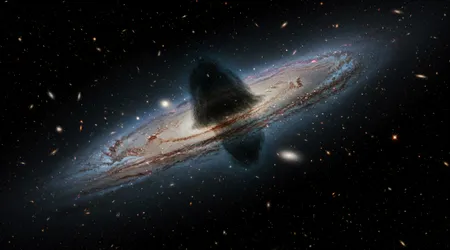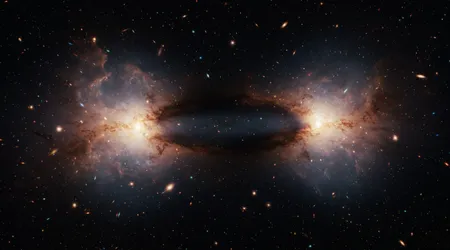The Dark Flow Mystery: Is Our Universe Being Pulled by Something Beyond?

The dark flow mystery captivates astronomers, hinting at unseen forces tugging our universe toward an unknown destination.
Anúncios
Discovered in 2008 by NASA’s Alexander Kashlinsky, this phenomenon suggests galaxy clusters move uniformly at 2.2 million miles per hour, defying standard cosmological models.
This article dives into the enigma, exploring its implications, scientific debates, and what it reveals about the cosmos. Why does this matter?
It challenges our understanding of the universe’s structure, suggesting influences beyond our observable reality. Let’s unravel this cosmic puzzle, blending cutting-edge research with thoughtful analysis, to see what lies beyond the veil of the known universe.
The dark flow mystery isn’t just a scientific curiosity it’s a window into the universe’s deepest secrets. Imagine a river pulling everything downstream, but the source remains invisible.
That’s the essence of dark flow: a coordinated motion of galaxy clusters that doesn’t align with the universe’s expected expansion.
This introduction sets the stage for a journey through cosmology, where we’ll explore theories, evidence, and the tantalizing possibility of a multiverse.
With recent 2025 studies reinforcing this phenomenon, we’ll examine how it reshapes our cosmic perspective, using real data and vivid examples to bring the mystery to life.
What Is the Dark Flow Mystery?
The dark flow mystery emerged from observing galaxy clusters moving in sync, unlike the random expansion predicted by the Big Bang. In 2008, Kashlinsky’s team, analyzing cosmic microwave background (CMB) data, noticed this peculiar motion.
Unlike gravitational pulls within our universe, this flow points to an external influence. Picture a cosmic current, dragging galaxies toward a specific direction toward the constellation Centaurus, to be precise.
This defies the uniformity expected in cosmic expansion, sparking intense scientific curiosity.
This motion, dubbed “dark flow,” suggests something massive beyond our observable universe exerts gravitational pull.
The 2025 study by Kashlinsky’s team, published in Nature Astronomy, confirms the flow extends 2.5 billion light-years, doubling previous estimates.
++ Are Time Loops Possible in Curved Spacetime?
This data strengthens the case for unseen structures, possibly in a multiverse, tugging at our cosmic fabric. The dark flow mystery thus challenges the standard cosmological model, urging scientists to rethink the universe’s boundaries.
To grasp this, consider a practical example: imagine marbles rolling across a table, all veering toward one corner despite no visible force. That’s the dark flow mystery in action galaxies moving as if drawn by an invisible magnet.
This phenomenon doesn’t fit neatly into Einstein’s general relativity or the Lambda-CDM model, which assumes uniform expansion. The mystery lies in what’s pulling these galaxies, and why it’s so consistent across vast distances.

Why Does Dark Flow Matter?
The dark flow mystery matters because it questions the foundation of cosmology. If galaxy clusters move uniformly, something massive must be pulling them something beyond our observable universe.
This could imply structures or forces outside our cosmic horizon, perhaps remnants of a pre-Big Bang era. The implications are profound: our universe might not be a closed system but part of a larger multiverse framework.
Consider the analogy of a fish in a bowl, unaware of the ocean outside. The dark flow mystery suggests our universe is that fishbowl, influenced by an unseen “ocean” of cosmic structures.
This challenges the Copernican principle, which posits our universe is isotropic uniform in all directions. If dark flow holds, it hints at a preferred direction, reshaping how we view cosmic evolution.
Also read: Could the Speed of Light Be Slowing Down Over Time?
Statistically, the dark flow mystery is significant. A 2025 study found a 99.9% confidence level that this motion isn’t random, based on 1,400 galaxy clusters observed.
This statistic underscores the phenomenon’s reality, pushing scientists to explore explanations like multiverse interactions or cosmic voids.
The mystery’s importance lies in its ability to redefine our place in the cosmos, sparking debates about the universe’s ultimate fate.
Theories Behind the Dark Flow
One theory posits the dark flow mystery results from gravitational pull by a massive structure beyond our observable universe. Kashlinsky suggests a pre-inflationary structure remnants from before the Big Bang could be responsible.
This implies our universe retains “memories” of a prior state, a radical idea challenging cosmic inflation theories. Such structures might exist in a multiverse, exerting influence across cosmic boundaries.
Another hypothesis links dark flow to cosmic voids regions with less matter that could create gravitational gradients.
Imagine a low-pressure system in weather, pulling air toward it; voids might similarly tug galaxies. However, 2025 data shows the flow’s consistency across vast distances, weakening this theory, as voids typically cause localized effects.
The dark flow mystery thus leans toward external influences, not internal ones.
Read more: Is the Universe Hiding an Unknown Force We Can’t Detect?
A third perspective, proposed by Nikodem Poplawski in 2025, suggests our universe’s rotation could mimic dark flow effects.
If the universe spins, it might create a directional bias, explaining the observed motion.
This theory, while speculative, ties dark flow to broader questions about cosmic rotation and black holes, offering a fresh lens on the mystery’s origins.
Challenges in Studying Dark Flow
Studying the dark flow mystery is daunting due to the universe’s vastness. Observing galaxy clusters 2.5 billion light-years away requires precise instruments like the Vera C. Rubin Observatory.
Its 3.2-billion-pixel camera, operational in 2025, maps cosmic structures, but even this struggles to detect influences beyond our observable universe. The challenge lies in measuring something we can’t directly see.
Another hurdle is distinguishing dark flow from cosmic noise. Galaxy motions are influenced by local gravity, dark matter, and expansion dynamics.
Filtering these to isolate dark flow demands sophisticated data analysis, like CMB radiation studies.
The dark flow mystery requires cross-referencing multiple datasets, a process prone to errors, yet essential for validating the phenomenon.
Skeptics argue dark flow could be a statistical fluke. Some 2025 studies question its significance, suggesting observational biases in CMB data.
However, Kashlinsky’s team counters with expanded datasets, reinforcing the flow’s reality.
This debate highlights the difficulty of studying phenomena at the universe’s edge, where evidence is scarce, and interpretations vary widely.
Implications for the Multiverse Hypothesis
The dark flow mystery fuels speculation about a multiverse a collection of universes beyond our own. If external structures pull our galaxies, they might reside in another universe, interacting gravitationally.
This aligns with theories like eternal inflation, where multiple universes form in a vast cosmic landscape. The mystery thus becomes a potential bridge to multiverse evidence.
Consider a practical example: if you feel a breeze through a closed window, you infer an outside source. Similarly, dark flow suggests external gravitational influences.
In 2025, theorists like Poplawski propose our universe might be inside a black hole in a larger cosmos, with dark flow as evidence. This idea, while unproven, excites cosmologists exploring multiverse dynamics.
Critics, however, caution against overreaching. The multiverse remains theoretical, lacking direct evidence beyond dark flow’s hints.
Alternative explanations, like cosmic voids or observational errors, still compete.
The dark flow mystery thus stands at a crossroads: it could confirm a multiverse or merely highlight gaps in our current models, urging cautious optimism.
Future Directions in Dark Flow Research

What’s next for the dark flow mystery? The Vera C. Rubin Observatory, with its 10-year Legacy Survey, will map galaxy motions in unprecedented detail.
By photographing the sky every few nights, it could pinpoint dark flow’s extent, offering clues about its cause. This survey promises to refine our understanding of cosmic dynamics.
Another avenue involves fast radio bursts (FRBs), which trace intergalactic matter. In 2025, the Deep Synoptic Array-2000 aims to detect 10,000 FRBs annually, potentially revealing how dark flow interacts with cosmic structures.
These bursts could map the gravitational influences driving the flow, bridging observational gaps.
Theoretical advancements also play a role. Simulations of multiverse interactions, using 2025 supercomputing advances, could model dark flow’s origins.
By integrating CMB data and galaxy cluster observations, researchers aim to test hypotheses like cosmic rotation or pre-inflationary structures, pushing the dark flow mystery closer to resolution.
Table: Key Data on Dark Flow Observations
| Year | Study Lead | Distance Observed | Galaxy Clusters | Confidence Level |
|---|---|---|---|---|
| 2008 | Kashlinsky | 1.2 billion light-years | 700 | 95% |
| 2025 | Kashlinsky | 2.5 billion light-years | 1,400 | 99.9% |
This table summarizes the evolution of dark flow research, highlighting the increased scope and confidence in 2025 findings.
Conclusion: A Cosmic Tug-of-War
The dark flow mystery invites us to question our cosmic place. Are we merely fish in a bowl, pulled by forces beyond our sight?
The 2025 data, showing galaxy clusters streaming at 2.2 million miles per hour, suggests our universe isn’t alone.
This phenomenon challenges the Big Bang’s uniformity, hinting at a multiverse or unseen structures.
As observatories like Vera C. Rubin and FRB studies advance, we edge closer to answers, yet the mystery deepens our awe of the cosmos.
This journey through the dark flow mystery reveals science’s power to confront the unknown. From Kashlinsky’s initial discovery to 2025’s expanded datasets, we’re piecing together a cosmic puzzle.
Whether it’s a multiverse, cosmic rotation, or something entirely new, dark flow pushes us to explore beyond the observable.
The universe is vast, and its secrets, like dark flow, remind us how much remains to discover. Stay curious our cosmic story is far from over.
Frequently Asked Questions
What is the dark flow mystery?
It’s the observed motion of galaxy clusters moving uniformly toward a specific direction, possibly due to gravitational pull from beyond our universe.
Could dark flow prove the multiverse?
It suggests external influences, supporting multiverse theories, but alternative explanations like cosmic voids exist. More data is needed to confirm.
How is dark flow studied?
Astronomers use CMB data, galaxy cluster observations, and FRBs, with tools like the Vera C. Rubin Observatory enhancing precision.
